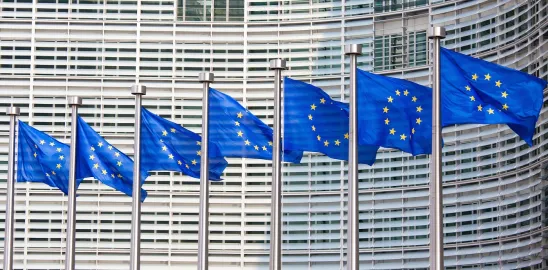A set of mandatory environmental, social, and governance (ESG) reporting standards, the European Sustainability Reporting Standards (ESRS), are set to enter into force in the European Union (EU) at the end of this year. These standards were adopted by the European Commission, the EU’s executive branch, on July 31, 2023 and, barring rejection by the European Parliament or the European Council, will be implemented as part of the EU’s Corporate Sustainability Reporting Directive (CSRD) – a fundamental pillar of the broad “EU Green Deal” – which requires mandatory ESG reporting for certain companies that do business in the EU. This summary provides an overview of who is subject to the CSRD and when, summarizes key information covered under this initial set of standards, highlights technical guidance from the entity that created the standards, and discusses planned future development of additional standards.
ESRS Overview
The ESRS were developed by the European Financial Reporting Advisory Group (EFRAG) and will require companies to provide detailed sustainability information related to their direct operations and supply chains. This effort is intended to promote transparency to investors, companies, society, and other stakeholders, as well as enhancing the comparability and reliability of sustainability information reported across the EU. The first 12 ESRS adopted by the Commission cover 2 “cross-cutting” standards comprised of general requirements plus 10 additional standards that are specific to either “E” (environment), “S” (social), or “G” (governance) topics.
Applicability of ESRS
The CSRD provides for a phased implementation of these mandatory reporting requirements, in which the timeline for when a company will be required to start reporting depends on certain criteria. Notably, the European Commission adopted an amendment to the thresholds triggering compliance obligations under the CSRD on October 17, 2023, with the goal of reducing the reporting burden on smaller companies and accounting for the effects of inflation. Companies will become subject to the CSRD according to the following timetable, although the criteria will change slightly for some categories if neither the European Parliament nor the European Council reject the European Commission’s recent amendment:
- 2024: Large, public companies that were already subject to reporting obligations under the precursor to the CSRD, the Non-Financial Reporting Directive (large listed companies, large banks, and large insurance undertakings, all with more than 500 employees), as well as large non-EU listed companies with more than 500 employees.
- 2025: All other large corporations, including large non-listed companies, for which two of the following three criteria are true: (1) an annual average of 250 employees or more, (2) total assets of €20 million (which would increase to €25 million under the Commission’s recent amendment), or (3) €40 million in sales (increased to €50 million under the Commission’s amendment).
- 2026: Small and Medium Sized Enterprises (SMEs) should be subject to reporting starting in 2027. However, the EU has not yet adopted reporting standards applicable to SMEs, which has led to some doubt as to the timing and scope of reporting obligations that will eventually apply to SMEs. Listed SMEs may eventually report using less intensive standards that are currently under development by EFRAG. Listed SMEs may also opt out of reporting requirements for two additional years, meaning they could wait to start reporting as late as 2029. Non-listed SMEs are not within the scope of the CSRD, but in the event they receive requests for sustainability information from investors or other stakeholders, they may opt to report under a trimmed down set of voluntary standards that EFRAG is also developing.
- 2028: Companies located outside the EU with subsidiaries or branches within the EU where sales exceed €150 million in the EU area over two years and are either (1) a large or listed subsidiary, or (2) a significant EU branch (over €40 million in turnover). The CSRD provides an opportunity to satisfy the reporting obligations for non-EU companies through “equivalent” reporting, but there is no guidance yet on what will be deemed equivalent.
For each of these phases, subject companies must submit reports consistent with the CSRD and ESRS beginning the year after they become subject to the CSRD.
Contents of ESRS
The delegated act contains 12 ESRS – 2 “cross-cutting” standards and 10 topical standards covering various sustainability issues. The cross-cutting standards – the General Requirements (ESRS 1) and General Disclosures (ESRS 2) – are applicable to all subject entities. ESRS 1 lays out general principles for reporting under the ESRS, and ESRS 2 prescribes essential information that all CSRD-subject companies must disclose. The 10 topical ESRS covered under the E, S, and G categories are subject to a materiality assessment. In other words, if a company determines it has no material impacts under a topical standard, it need not disclose information under that standard and can simply report the data point(s) as “not material.” Therefore, some companies may not need to make disclosures under all of the various topical standards. However, companies that determine that the climate change standard – ESRS E1 – is not material for their business must nonetheless explain how that determination was made. Below is a brief summary of the structure and topics covered under the first 12 mandatory ESRS, along with some important information covered under each category.
General Requirements and Disclosures: ESRS 1 contains mandatory principles for disclosure of information, but does not contain any specific content which must be reported. It provides the basis on which reports will be prepared. For example, it sets forth the materiality assessment which governs the scope of required disclosures under the topical standards. ESRS 2 sets forth general information that must be reported regardless of materiality. Additionally, it defines four disclosure areas to apply to the topical standards: governance, strategy, risks and opportunities, and metrics and targets.
- ESRS 1: General Requirements
- ESRS 2: General Disclosures
Environmental Information: ESRS E1 through E5 contain required disclosure of both qualitative and quantitative information covering a range of environmental topics.
- ESRS E1: Climate
- ESRS E2: Pollution
- ESRS E3: Water and Marine Resources
- ESRS E4: Biodiversity and Ecosystems
- ESRS E5: Resource Use and Circular Economy
Social Information: ESRS S1 through S4 contain required disclosure of largely qualitative information covering a range of social topics.
- ESRS S1: Own Workforce
- ESRS S2: Workers and the Value Chain
- ESRS S3: Affected Communities
- ESRS S4: Consumers and End Users
Governance Information: The governance category refers to corporate business strategy and oversight over sustainability issues, including the processes for evaluating and managing environmental and social risks and opportunities.
- ESRS G1: Business Conduct
Key Principles and Takeaways
Compliance with the ESRS requires understanding of certain key principles that underlie the structure and requirements of the standards:
Double Materiality: As described above, the 10 topical ESRS require a materiality assessment. The materiality assessment requires that companies employ a “double materiality” perspective, meaning they must report on two types of material impacts:
- Financial Materiality: Companies must report on how social and environmental issues create financial risks and opportunities for the company.
- Impact Materiality: Companies must report on the impacts of the company on people, the environment, and society in general.
Both capture both positive and negative sustainability-related impacts for a business. A sustainability-related matter is material and thus must be reported under the ESRS if it is material from either an impact or financial materiality perspective, or both.
Diligence Process: Companies will report on the due diligence processes they use to identify potential impacts to and from social and environmental factors, for example, stakeholder engagement throughout the operations and supply chain. The due diligence process informs conclusions on which standards are material.
Reporting Logistics: Companies will be required to prepare a sustainability statement with the disclosures required by the ESRS as part of their annual management report, effectively incorporating ESG reporting into traditional financial reporting mechanisms.
Assurance: Disclosures will be subject to external assurance requirements, beginning with a limited assurance requirement but potentially later transitioning to a more rigorous reasonable assurance standard. Assurances must cover both the substantive information disclosed for each topic, as well as the materiality assessments.
Alignment with Other Global Standards: EFRAG and the European Commission made a demonstrated effort to align the ESRS with other global sustainability reporting frameworks, in an attempt to ease the potential reporting burden. As such, the ESRS as adopted by the Commission bear a lot of similarity to other global sustainability reporting standards, including primarily the International Sustainability Standards Board (ISSB) standards and the Global Reporting Initiative (GRI) standards. EFRAG worked with ISSB to develop standards in tandem and to align where possible. It also looked to existing frameworks, such as GRI, which is already in use by thousands of companies, as a reference. EFRAG is working with both of these entities to publish interoperability guidance materials to assist companies reporting under multiple frameworks and minimize duplication of work. Moreover, the CSRD provides for non-EU companies subject to its obligations, such as US parent companies, to use sustainability standards equivalent to the ESRS, although what standards may be deemed “equivalent” is not yet clear.
EFRAG Standards Development
EFRAG is an independent, multistakeholder advisory body, majority funded by the EU. It played a significant role in developing the ESRS, with the close involvement of investors, companies, auditors, civil society, trade unions, academics, and national standard-setters. The ESRS adopted by the European Commission reflect a number of significant modifications to EFRAG’s draft version, including the addition of phase-in periods for certain standards, greater flexibility for companies by making more standards subject to companies’ materiality determinations, and making certain especially challenging or costly disclosures voluntary.
Now, EFRAG will publish non-binding technical guidance to support compliance with the ESRS. It has already put forth draft implementation guidance for the materiality assessment. It will prioritize issuing finalized guidance on materiality and company value chains and is expected to maintain a website to field technical questions on the ESRS.
EFRAG is also charged with developing a second set of sector-specific ESRS under the CSRD, applicable to the industrial sectors for oil and gas; coal, quarries, and mining; road transport; agriculture, farming, and fisheries; motor vehicles; energy production and utilities; food and beverages; and textiles, accessories, footwear, and jewelry. Although a delegated act with this second set of ESRS is due to be adopted under the CSRD by 2024, with applicability of sector-specific standards beginning in 2026, the European Commission announced its intent to postpone adopting the sector-specific standards in its 2024 Work Programme. EFRAG is also expected to promulgate standards for listed SMEs and voluntary standards for non-listed SMEs.
Next Steps
After the first set of ESRS were adopted by the European Commission on July 31, 2023, the standards were formally transmitted to the Council of the EU and the European Parliament for review. Objections to the ESRS were unsuccessful, so the first set of ESRS will enter into force as planned once it is published in the Official Journal of the EU.







 />i
/>i
